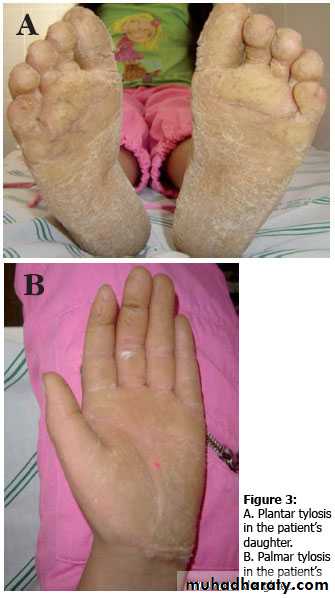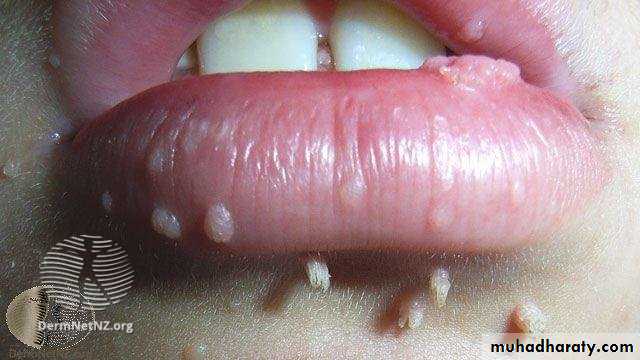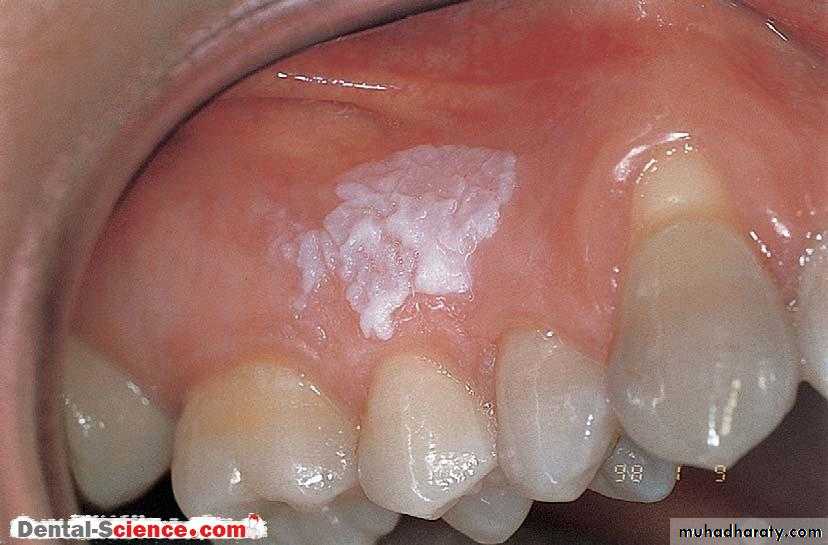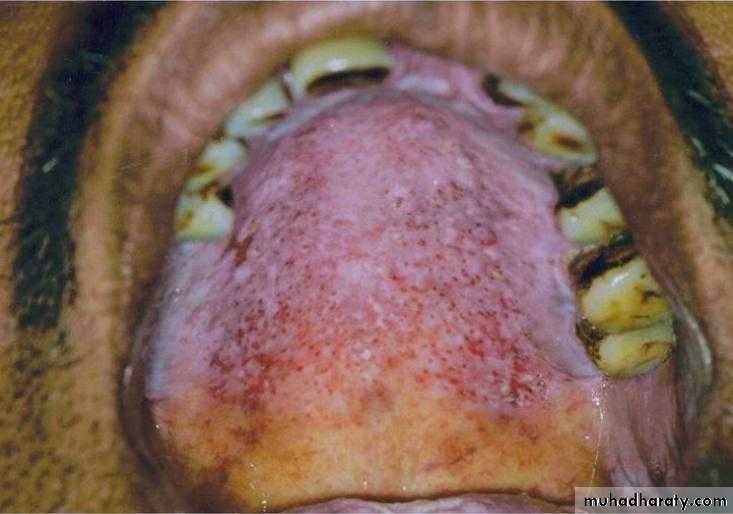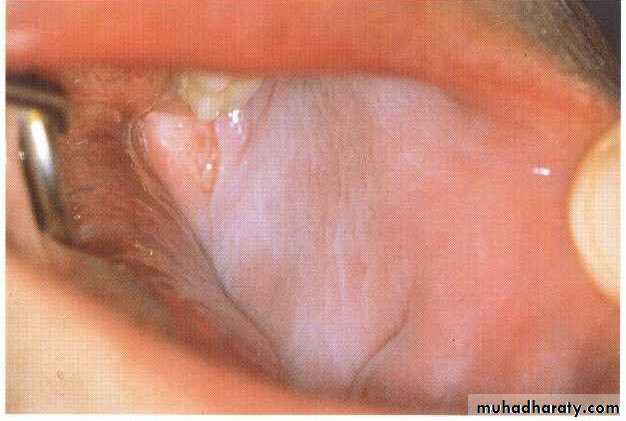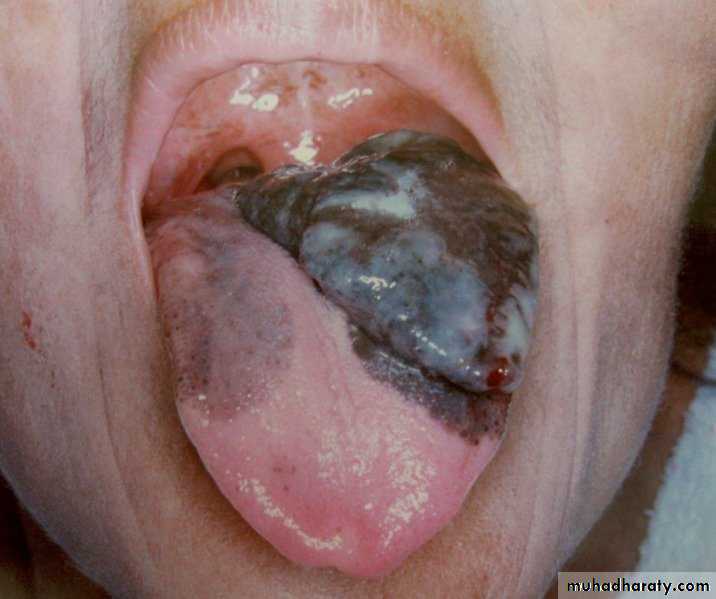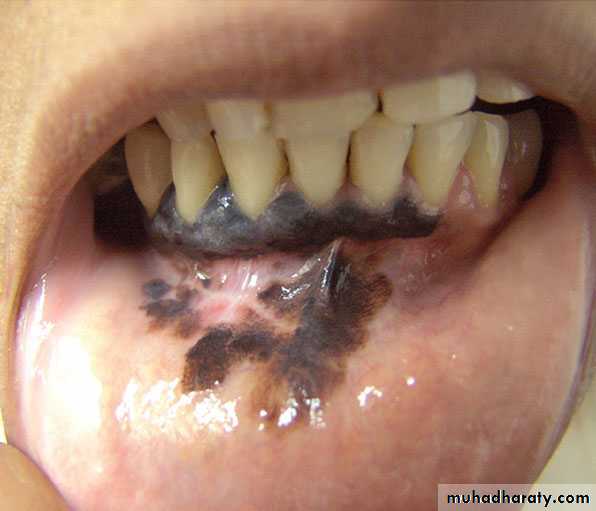Tylosis (palmoplantar keratoderma)
white lesions of the oral mucosa,oesophageal carcinoma, and tylosis (hyperkeratosis of the palms and soles.
histologically resemble those of a leukokeratosis.
This latter syndrome, like most other dermal mucosal syndromes of this type, is transmitted as a dominant condition
Darier's disease
also known as follicular keratosisIt is usually first seen in young adults and generally manifests as greasy brownpapules on the chest and shoulders
The oral mucosa is affected in a significant proportion of cases and the disease usually presents as coalescent white lesions on the buccal mucosae or palate
Benign neoplasms
The most common neoplasms affecting oral mucosa are the squamous cellpapilloma, which is a benign tumour, and squamous cell carcinoma, which is a malignant tumour
A number of connective-tissue neoplasms (for
example, fibromas, lipoma) can occur in the mouth but these are less common
Squamous cell papilloma
This benign epithelial neoplasm is relatively common. It may appear anywhere on the oralmucosa, but is most commonly found at the junction of the hard and soft palates.
Its typical appearance is cauliflower-like
Treatment of a papilloma is by local excision. This, however, must be sufficiently wide and deep to include any abnormal cells that may extend beyond the area of the pedicle.
Removal with a laser is an alternative
occasionally occur in the mouth or, more commonly, on and around the lips. In children these are often the result of autoinoculation by chewing warts on the hands.
Miscellaneous benign conditions1_Traumatic keratoses
caused by a local reaction to earlier physical, mechanical, electrical, or thermal causes and are reversible. Chemical trauma caused by an irritant substance, such as topical use of an aspirin, can cause either oral ulceration.
Lesions seen on the oral mucosa of individuals who smoke cigarettes, cigars, or pipes are due to a combination of chemical and thermal insults.
Frictional keratosis
the large majority are reversible, completely disappearing if the trauma is removed.It is of interest to recall that the mucosal response to trauma most often seen in the oral cavity is that of the denture granuloma
The principal change in this particular lesion is in the connective tissue component of the mucosa rather than in the epithelium.
Nicotinic stomatitis (pipe-smokers' palate)
usually found, as the name implies, in pipe-smokers, but also,occasionally, in cigarette- and cigar-smokers. The characteristic
histological feature of this condition is the combination of epithelial acanthosis and hyperkeratosis with inflammatory
changes in the mucous glands of the palate.
As a result of these changes, the palate becomes white and a number of nodules project from the surface
Management is directed at persuading the patient to stop smoking
Leukoedema
Leukoedema is the name given to a filmy grey coating of the buccal mucosa that is found in a high proportion of patientsHistologically, this lesion has been described as being parakeratotic, with large swollen cells in the superficial layers of the epithelium
Leukoedema is not associated with epithelial atypia and should not be regarded as a premalignant lesion
Pigmentation of the oral mucosa
Pigmentation of the oral mucosa can occur as a result of environmental or occupationas exposure to heavy metal salts, such as mercury,Following absorption of the metals, they are deposited as metallic sulfides as a grey (or blue/black) line along the marginal gingivae.
Amalgam tattoos
Amalgam tattoos are a result of fragments of the material being embedded in the oral mucosaAmalgam tattoos may be radio-opaque
They usually occur on the floor of the mouth or alveolar mucosa, near to existing or previous amalgam restorations
Melanotic pigmentation of oral mucosa
Oral melanosis may occur in HIV infection A number of drugs may also stimulateincreased pigmentation including oral contraceptives, antimalarials, and major tranquillizers
Increased melanin production may also occasionally be seen in association with the oral lesions of lichen planus and with leukoplakias
Melanotic pigmentation of the oral mucosa: principal causes
RacialAddison's disease
HIV disease
Reactive
Lichen planus and leukoplakia
Drug-related
Melanotic naevus
Malignant melanoma
Oral melanoma
Intraoral melanomas are highly malignant oral tumours that usually occur as isolated dark brown or black patches on the oral mucosa.
In the early stages they may be symptomatic. The appearance is usually of a nodular or macular lesion that is firm to palpate.
This ultimately ulcerates and causes discomfort or bleeds
The prognosis for oral melanoma is poor.
Superficial spreading melanomas are rarely seen in the mouth and
their appearance can be quite spectacular.

